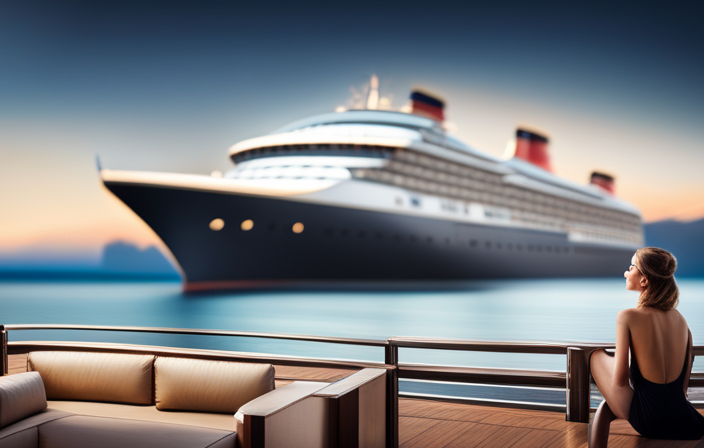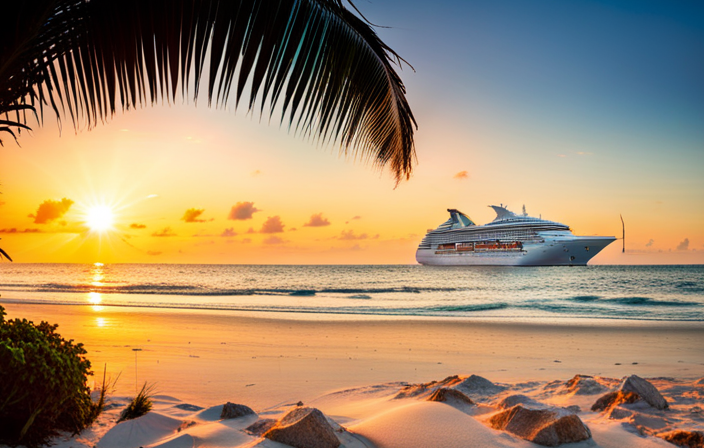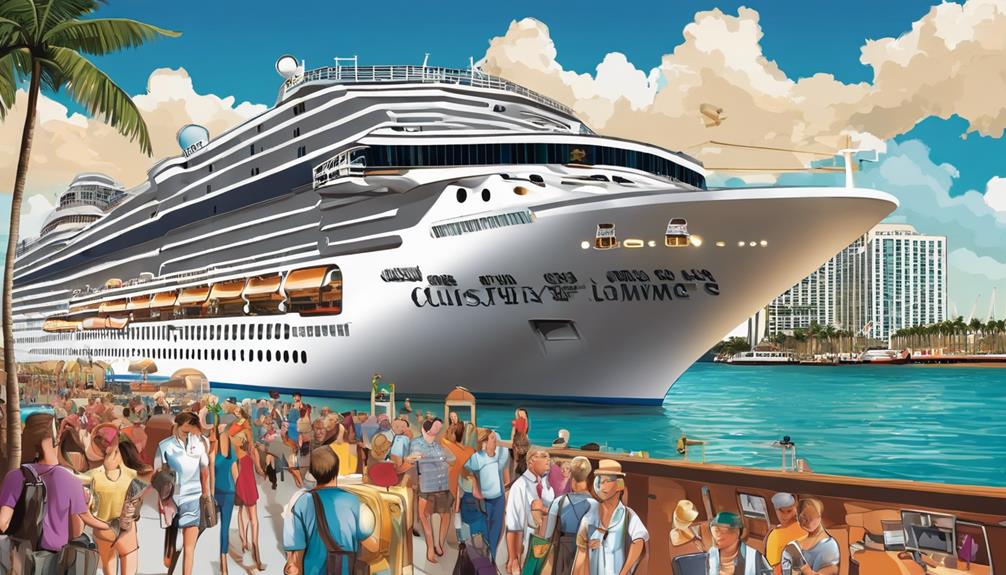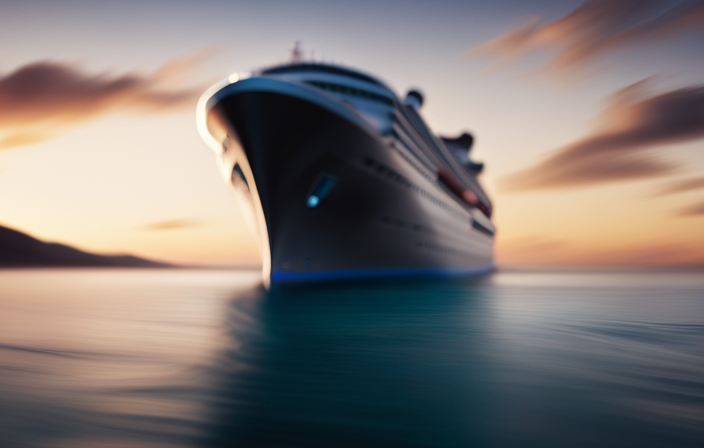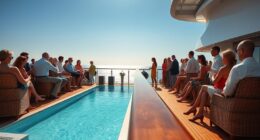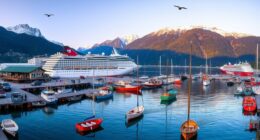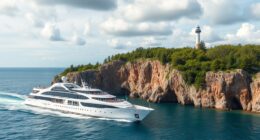As I stood on the deck of a massive cruise ship by happenstance, I couldn’t help but wonder: what goes into building these magnificent vessels? Astonishingly, the answer encompasses a fascinating combination of engineering feats, technological progress, and detailed artisanry.
Cruise ships are constructed using a combination of steel, aluminum, and other materials, carefully selected to provide strength, durability, and safety on the high seas.
The structural framework of these floating marvels is meticulously designed, with intricate support systems and reinforcements ensuring the ship’s stability and ability to withstand the forces of nature. Inside, the interior design and furnishings are thoughtfully chosen to create an elegant and comfortable environment for passengers.
But it’s not just the materials and design that make cruise ships remarkable. These modern marvels are equipped with advanced technology and systems, from propulsion systems to electrical systems, all working seamlessly to ensure a smooth and luxurious experience for passengers.
In this article, we will delve into the details of what cruise ships are made out of, exploring the various materials, technologies, and construction processes that go into creating these extraordinary vessels.
Key Takeaways
- Cruise ships are made using a combination of steel, aluminum, and other materials to ensure strength, durability, and safety on the high seas.
- The structural framework of cruise ships is meticulously designed using steel as the primary material, with aluminum alloys used in some areas to reduce weight without sacrificing strength.
- Cruise ship interiors are designed with high-quality materials like rich woods and polished metals, showcasing impeccable craftsmanship and blending contemporary styles with classic elements.
- Cruise ships are equipped with advanced technology and systems, including advanced navigation and control systems, state-of-the-art communication systems, cutting-edge entertainment systems, and efficient energy and waste management systems.
The Structural Framework of Cruise Ships
The structural framework of cruise ships is a crucial component for their stability and durability. High-strength steel is the primary material used in construction, offering resilience against the harsh marine environment. This steel is carefully chosen for its corrosion resistance and ability to withstand fatigue. In some areas, aluminum alloys are used to reduce weight without sacrificing strength. These materials undergo rigorous testing and quality control to meet safety standards. Once the solid foundation is established, cruise ships can proceed to the interior design and furnishings, creating a luxurious and comfortable onboard experience.
The Interior Design and Furnishings
Let’s dive into the fascinating world of cruise ship interiors and the beautiful furnishings that bring them to life! The interior decor of cruise ships is designed to create a luxurious and elegant atmosphere for passengers to enjoy throughout their journey. Here are four key elements that contribute to the opulence of cruise ship interiors:
-
High-quality materials: Cruise ship interiors are adorned with top-notch materials such as rich woods, polished metals, plush fabrics, and sumptuous carpets. These materials exude sophistication and add a touch of luxury to the overall design.
-
Impeccable craftsmanship: Skilled artisans meticulously craft every detail of the furnishings and decor found on cruise ships. From the furniture to the decorative elements, each piece is expertly made and visually stunning, showcasing the talent and dedication of these craftsmen.
-
Elegant designs: Cruise ship interiors feature elegant and timeless designs that blend contemporary styles with classic elements. The overall design creates an ambiance of refined beauty, ensuring that passengers feel surrounded by luxury and comfort throughout their voyage.
-
Thoughtful touches: Every aspect of the interior design is carefully thought out to enhance the overall aesthetic. Intricate lighting fixtures, intricately patterned wallpapers, and other thoughtful touches are incorporated to create a visually stunning environment that captivates passengers and adds to the overall experience.
Now, let’s explore the technology and systems that make these magnificent cruise ships operate smoothly.
The Technology and Systems
The technology and systems on cruise ships are incredibly advanced and precise.
One key aspect is the advanced navigation and control systems, which ensure the safety and efficiency of the ship’s movements.
Additionally, state-of-the-art communication and entertainment systems provide passengers with seamless connectivity and a wide range of entertainment options.
Lastly, efficient energy and waste management systems are in place to minimize the environmental impact of the ship and ensure sustainability.
Advanced Navigation and Control Systems
Imagine yourself aboard a magnificent cruise ship, where state-of-the-art navigation and control systems guide your journey through the vast ocean. These advanced navigation systems are equipped with cutting-edge technology, allowing for precise location tracking, route planning, and collision avoidance. The control system integration ensures seamless coordination between various components of the ship, such as propulsion, steering, and stabilizers.
These systems enhance safety by constantly monitoring environmental conditions and adjusting the ship’s course accordingly. They optimize fuel consumption by analyzing weather patterns and sea currents to find the most efficient routes. They provide real-time data to the crew, allowing them to make informed decisions and respond swiftly to any emergencies.
As we transition into the next section about state-of-the-art communication and entertainment systems, it is clear that these advanced navigation and control systems are just a glimpse of the technological marvels that await you on a modern cruise ship.
State-of-the-Art Communication and Entertainment Systems
Get ready to be immersed in a world of cutting-edge communication and entertainment systems that will transport you to new dimensions of enjoyment and connectivity.
On modern cruise ships, state-of-the-art communication systems ensure that passengers and crew can stay connected with the outside world at all times. These systems utilize satellite technology, advanced antennas, and high-speed internet to provide seamless communication capabilities even in the middle of the ocean.
Additionally, cutting-edge entertainment systems offer a wide range of options to keep passengers entertained throughout their journey. From interactive virtual reality experiences to immersive theaters and live performances, these entertainment systems are designed to create unforgettable moments for passengers of all ages.
As we delve into the next section about efficient energy and waste management systems, it becomes apparent that every aspect of a cruise ship is designed to maximize efficiency and minimize environmental impact.
Efficient Energy and Waste Management Systems
Prepare to be amazed by the efficient energy and waste management systems on modern cruise ships. Over 80% of the onboard waste is recycled, leaving a positive impact on our environment and inspiring you to join the sustainability movement.
These ships are equipped with state-of-the-art technology that enables efficient waste management. Through advanced sorting and processing systems, recyclable materials such as paper, plastic, glass, and metal are separated and sent for recycling, reducing the amount of waste that goes to landfills.
Additionally, energy-saving initiatives are in place to minimize the ships’ environmental footprint. These include the use of LED lighting, energy-efficient appliances, and advanced HVAC systems that optimize energy consumption. By implementing these systems, cruise ships are able to significantly reduce their energy consumption and greenhouse gas emissions.
With such innovative practices in place, cruise ship companies are leading the way in promoting sustainable and responsible tourism.
Transitioning into the subsequent section about ‘the accommodation and passenger areas’, these eco-friendly initiatives extend beyond waste management and energy conservation.
The Accommodation and Passenger Areas
Passenger areas on cruise ships, such as cabins and public spaces, are meticulously designed and constructed to provide a luxurious and comfortable experience for travelers.
Accommodation design takes into consideration the spatial limitations of a ship, while maximizing comfort and functionality. Cabins are carefully planned to optimize space utilization, featuring modern amenities and elegant furnishings. The use of high-quality materials and plush bedding ensures a restful sleep for passengers.
Public spaces, including lounges and dining areas, are designed to create a welcoming atmosphere, with attention to detail in lighting, seating, and decor. Passenger comfort is further enhanced through the incorporation of noise reduction technology and climate control systems, ensuring a pleasant environment regardless of external conditions.
As we transition into the subsequent section about the onboard amenities and features, it is important to note that these areas are integral to the overall cruise ship experience, providing additional entertainment and relaxation options to passengers.
The Onboard Amenities and Features
Step aboard and immerse yourself in a world of opulence and endless possibilities as you discover the onboard amenities and features that will leave you with unforgettable memories. Cruise ships are designed to provide a wide range of onboard entertainment options and dining experiences to cater to every passenger’s preferences. From Broadway-style shows and live music performances to movie theaters and casinos, there is never a dull moment on board. As for dining, cruise ships offer a plethora of options, from formal dining rooms and specialty restaurants to buffets and cafes. The table below highlights some of the onboard amenities and features:
| Onboard Entertainment Options | Dining Experiences |
|---|---|
| Broadway-style shows | Formal dining rooms |
| Live music performances | Specialty restaurants |
| Movie theaters | Buffets |
| Casinos | Cafes |
| Sports facilities | Room service |
Transitioning into the subsequent section about the safety and security measures, it is essential to note that cruise ships prioritize the well-being and protection of their passengers at all times.
The Safety and Security Measures
After exploring the luxurious amenities and features onboard a cruise ship, it is important to delve into the safety and security measures in place.
Cruise ships prioritize the safety of their passengers and crew through extensive safety training and emergency protocols. Crew members undergo rigorous training programs to ensure they are well-prepared to handle any emergency situation that may arise. These training programs include fire drills, evacuation procedures, and first aid training.
Additionally, cruise ships are equipped with state-of-the-art safety equipment, such as lifeboats, fire suppression systems, and advanced navigation systems.
Strict security measures are also implemented to protect the passengers and prevent any untoward incidents. With safety being paramount, cruise ships ensure that every passenger can enjoy their voyage with peace of mind.
Now, let’s explore the environmental considerations that cruise ships take into account.
The Environmental Considerations
When it comes to environmental considerations, cruise lines are taking steps to protect the oceans and minimize their carbon footprint. Cruise ships are designed with eco-friendly practices in mind. For instance, many ships have advanced wastewater treatment systems to ensure clean and safe water discharge. Cruise lines also invest in energy-efficient technologies, like LED lighting and advanced propulsion systems, to reduce fuel consumption and greenhouse gas emissions. Waste management programs are implemented, recycling as much as possible and reducing single-use plastics onboard. These efforts demonstrate the industry’s commitment to sustainable practices and preserving the marine environment.
Moving on to the construction and assembly process, cruise ships are meticulously crafted using a combination of steel, aluminum, and other materials. This ensures durability and safety while providing a luxurious experience for passengers.
The Construction and Assembly Process
When it comes to the construction and assembly process of cruise ships, there are several key points to consider.
Shipyard facilities and equipment play a crucial role in ensuring the smooth and efficient construction of these massive vessels.
Building blocks and sections are carefully crafted and assembled to form the structure of the ship, with precision and attention to detail.
Integration and testing processes ensure that all components are properly integrated and function as intended before the ship is ready to set sail.
Shipyard Facilities and Equipment
Shipyard facilities and equipment play a crucial role in the awe-inspiring creation of massive cruise ships. These state-of-the-art facilities are equipped with cutting-edge technology and machinery that streamline the construction process. Shipyard equipment, such as gantry cranes and heavy-duty lifts, are used to maneuver the ship’s components during assembly. Additionally, specialized welding machines and robotic arms ensure precise and secure connections between various sections of the ship.
To give you a glimpse of the scale and complexity of these shipyard facilities, here is a table showcasing some essential equipment:
| Equipment | Description |
|---|---|
| Gantry Cranes | Used for lifting heavy ship components |
| Heavy-Duty Lifts | Transport sections during assembly |
| Welding Machines | Ensure secure connections |
| Robotic Arms | Aid in precise assembly |
These facilities are the building blocks and sections, where the magic of cruise ship construction takes place.
Building Blocks and Sections
Moving on from shipyard facilities and equipment, let’s delve into the fascinating world of building blocks and sections in the construction of cruise ships.
These massive vessels are made using a variety of high-quality building materials, carefully selected to withstand the harsh marine environment.
The construction process involves assembling individual sections, known as building blocks, which are then joined together to form the ship’s structure.
These building blocks are typically made of steel, as it provides the necessary strength and durability required for a cruise ship.
Each block is meticulously designed and manufactured to fit seamlessly with the others, ensuring a solid and watertight structure.
Once these building blocks are integrated, the ship moves on to the next phase of integration and testing, where its systems and components are meticulously inspected and verified.
Integration and Testing
Now let me take you on a journey through the intricate process of integrating and testing. You’ll witness the harmonious fusion of countless components and the birth of a magnificent floating wonder.
Integration testing plays a crucial role in ensuring the smooth functioning of a cruise ship. It involves combining individual sections, testing their compatibility, and identifying any potential issues.
This stage includes electrical integration, where complex systems are interconnected and checked for proper functioning. Mechanical integration involves joining various structural components and assessing their stability.
Quality assurance is of utmost importance during integration and testing. It ensures that every system, from propulsion to navigation, operates flawlessly. By meticulously scrutinizing and rectifying any discrepancies, we guarantee the highest standards of safety and performance.
As we conclude the integration and testing phase, we can now delve into the subsequent section. Here, we will explore the meticulous maintenance and upkeep required to preserve the splendor of these magnificent vessels.
The Maintenance and Upkeep of Cruise Ships
Regular inspections and repairs are crucial to ensure the safety and efficiency of cruise ships. These inspections involve thorough checks of the ship’s structural integrity, mechanical systems, and safety equipment. Any necessary repairs or replacements are promptly carried out to prevent issues during operation.
Dry docking and refurbishment are essential processes that involve taking the ship out of the water for extensive maintenance. This includes hull cleaning, painting, and upgrading various onboard facilities.
Cleaning and sanitization procedures are meticulously followed to maintain the highest level of hygiene. This helps prevent the spread of diseases among passengers and crew members.
Regular Inspections and Repairs
Don’t worry, you’ll be glad to know that cruise ships are built with durable materials that undergo regular inspections and necessary repairs to ensure your safety and comfort.
These regular inspections are conducted by trained professionals who meticulously examine every aspect of the ship, from the hull to the onboard systems. Any signs of wear and tear, corrosion, or other issues are promptly addressed and repaired to maintain the ship’s integrity.
These inspections also include checking the safety equipment and emergency systems to ensure they are in proper working condition. Additionally, routine maintenance procedures are carried out to prevent any potential problems from arising.
By adhering to these rigorous inspection and repair protocols, cruise ships are able to operate at their optimal level of performance and safety.
As we transition into the next section about dry docking and refurbishment, it is important to note that these regular inspections and repairs are just one aspect of the comprehensive maintenance program in place for cruise ships.
Dry Docking and Refurbishment
You’ll be amazed at the transformation that takes place during dry docking and refurbishment, as your floating vacation home undergoes a complete makeover to provide you with even more luxurious and updated amenities. Dry docking procedures involve taking the cruise ship out of the water and placing it in a dry dock, allowing maintenance and repairs to be conducted on the hull and other underwater components. This is also the perfect opportunity to upgrade and enhance the ship’s facilities and features. Refurbishment techniques include renovating cabins, restaurants, and entertainment areas, as well as updating technology systems and improving energy efficiency. To give you an idea of the magnitude of these improvements, take a look at the table below:
| Dry Docking Procedures | Refurbishment Techniques |
|---|---|
| Hull maintenance | Cabin renovations |
| Propeller inspection | Restaurant upgrades |
| Underwater repairs | Entertainment area revamp |
As the refurbishment is completed, the ship not only looks brand new, but it also incorporates the latest advancements in comfort and entertainment. This ensures that your next cruise experience will be even more enjoyable and unforgettable. Moving forward, let’s explore the extensive cleaning and sanitization procedures implemented onboard to ensure the highest level of safety and hygiene for all passengers and crew members.
Cleaning and Sanitization Procedures
Get ready to discover the meticulous cleaning and sanitization procedures that ensure the utmost safety and hygiene onboard.
Cruise ships follow stringent cleaning protocols that leave no room for compromise. High-touch surfaces such as handrails, elevator buttons, and door handles are regularly disinfected using hospital-grade cleaners.
Cabin cleaning involves thorough vacuuming, dusting, and sanitizing of all surfaces, including bedding and upholstery. Special attention is given to bathrooms, where disinfection methods such as ultraviolet light and electrostatic sprayers are employed to eliminate any potential pathogens.
Public areas undergo frequent deep cleaning, with a focus on high traffic zones. Additionally, air filtration systems are equipped with HEPA filters to remove airborne contaminants.
These comprehensive cleaning and sanitization practices ensure a safe and healthy environment for all passengers and crew onboard.
Transitioning into the future of cruise ship construction, new advances in materials and technology promise even greater levels of cleanliness and hygiene without compromising on luxury and comfort.
The Future of Cruise Ship Construction
In the future of cruise ship construction, we’ll see the use of innovative materials and design concepts, which will revolutionize the industry. These materials will enhance the structural integrity of the ships and improve energy efficiency, reducing environmental impact.
Sustainable and green technologies will be integrated into the construction process, ensuring that cruise ships are built with a focus on environmental responsibility.
Trends in passenger experience and comfort will drive the design of future cruise ships. There will be a focus on creating luxurious and enjoyable spaces for travelers.
Innovative Materials and Design Concepts
Step aboard a cruise ship and brace yourself for a voyage filled with cutting-edge materials and design concepts that will blow your mind.
Cruise ship construction has entered a new era, with innovative materials and design concepts shaping the industry. Advanced composite materials, such as carbon fiber reinforced plastic, are being used to create stronger and lighter structures, enhancing fuel efficiency and overall performance.
These materials not only improve the ship’s durability but also allow for more flexibility in design, enabling architects to create stunning and unique spaces onboard.
Furthermore, new design concepts are revolutionizing the cruise ship experience. From multi-level atriums to glass-bottomed pools, these concepts offer passengers breathtaking views and an immersive environment.
As we move forward, sustainable and green technologies will take center stage, ensuring that cruise ships continue to evolve and minimize their environmental impact.
Sustainable and Green Technologies
By incorporating sustainable and green technologies, cruise ship construction is spearheading a new era of environmentally conscious design and operation. To achieve this, cruise ships are adopting innovative green propulsion systems and utilizing eco-friendly materials. Green propulsion systems include the use of liquefied natural gas (LNG) as a fuel source, reducing harmful emissions. Additionally, some ships are incorporating advanced energy storage systems to optimize power usage and reduce fuel consumption. In terms of materials, shipbuilders are utilizing sustainable alternatives such as recycled steel, low-emission paints, and energy-efficient lighting systems. These measures not only minimize environmental impact but also enhance energy efficiency and reduce operational costs. Aesthetic beauty is not compromised either, as these materials are designed to be visually appealing. Moving forward, these sustainable practices will continue to evolve, ensuring that cruise ships provide an eco-friendly and enjoyable experience for passengers. Transitioning to the next section, the trends in passenger experience and comfort are also influenced by these sustainable technologies and materials.
Trends in Passenger Experience and Comfort
Enhance your cruise experience with the latest trends in passenger comfort and enjoyment. As cruise ships continue to evolve, passenger satisfaction becomes a top priority, and luxury amenities play a crucial role in achieving that goal. Here are three trends that are shaping the passenger experience on modern cruise ships:
-
Smart Technology Integration: Cruise lines are incorporating advanced technology to provide passengers with seamless connectivity and personalized experiences. From smart cabin controls to wearable devices that track preferences and activities, passengers can enjoy a more convenient and tailored experience.
-
Enhanced Dining Options: Cruise ships are offering a wide range of dining options to cater to different tastes and dietary preferences. From specialty restaurants featuring world-renowned chefs to themed dining experiences, passengers can indulge in a variety of culinary delights.
-
Spa and Wellness Facilities: Cruise ships are investing in state-of-the-art spa and wellness facilities to promote relaxation and rejuvenation. From luxurious spa treatments to fitness centers equipped with the latest equipment, passengers can pamper themselves while sailing the seas.
By incorporating these trends, cruise ships are elevating passenger satisfaction and ensuring a truly luxurious experience for all.
Frequently Asked Questions
How much does it cost to build a cruise ship?
To determine the cost of building a cruise ship, one must consider various factors such as size, amenities, and materials used. The construction timeline can range from several years for larger vessels to a few months for smaller ones.
What materials are used for the exterior of a cruise ship?
For the exterior of a cruise ship, materials such as aluminum and steel are commonly used. These materials provide the necessary strength and durability to withstand the harsh marine environment and ensure the safety of the ship and its passengers.
Are there any regulations or standards in place for cruise ship construction?
There are regulations in place that impact cruise ship construction. These regulations focus on ensuring environmental sustainability, such as reducing emissions and waste. Standards are set to improve safety, structural integrity, and passenger comfort.
How long does it take to build a cruise ship?
Building a cruise ship is a complex process that requires meticulous planning and coordination. From the initial design to the final touches, the construction timeline can range from two to three years, depending on the size and specifications of the vessel.
How often are cruise ships inspected for safety and maintenance?
Cruise ships undergo regular safety inspections and maintenance protocols. The frequency of these inspections is determined by international regulations and industry standards. Stringent measures are taken to ensure the safety and maintenance of cruise ships.
How Does the Material of a Cruise Ship Affect its Draft?
The draft of a cruise ship is greatly influenced by the material used in its construction. Lighter materials such as aluminum or fiberglass can reduce the weight of the ship, resulting in a shallower draft. On the other hand, heavier materials like steel may increase the draft of the cruise ship.
Conclusion
In conclusion, cruise ships are complex structures made of various materials such as steel, aluminum, and fiberglass. These materials provide strength, durability, and resistance to harsh marine conditions.
An example of the importance of material choice is the case of the Carnival Triumph. In 2013, a fire broke out on the ship due to a fuel oil leak, causing the vessel to lose power. The use of fire-resistant materials and effective evacuation systems ensured the safety of the passengers and crew.
This highlights the significance of careful construction and design considerations in creating a safe and enjoyable cruising experience.

